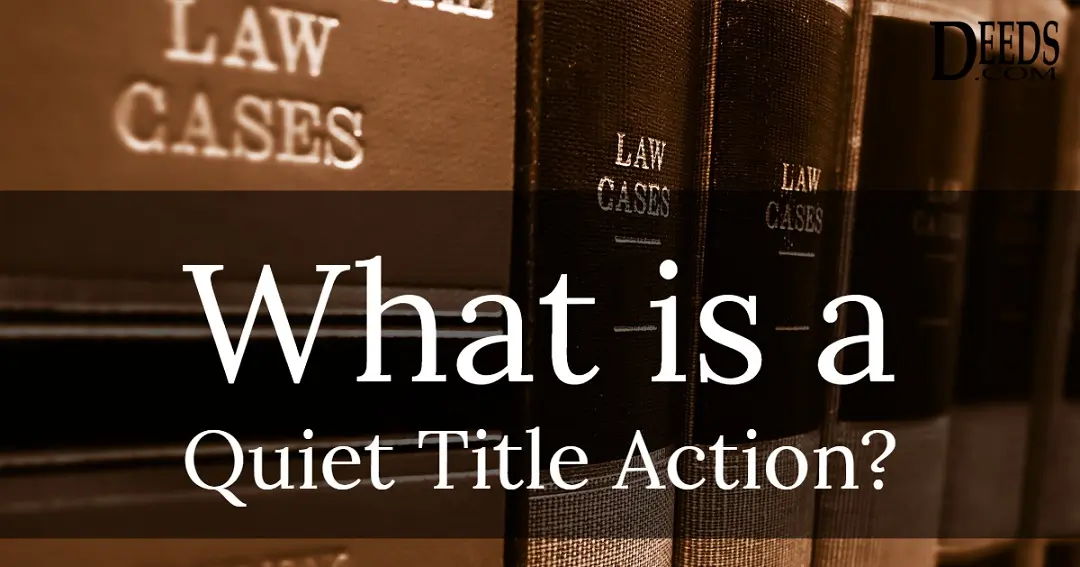
A quiet title action is a special legal proceeding to determine rightful, legal property ownership. It is often a preventative or “friendly” lawsuit to ensure that no other parties have conflicting claims to a title, or to resolve an ambiguity. Depending on state law provisions, the plaintiff—that is, the party filing the complaint—may be the mortgage lender, a potential buyer, the legal title holder, or someone in actual possession of the property.
Prevailing in a quiet title action enables the rightful owner to get title insurance, to take a loan out on the property, and to convey the property free and clear of any cloud on the title.
When to File a Quiet Title Action
Whenever doubt or ambiguity arises as to ownership in a title search, the title company will not issue a title insurance policy. This means the property lacks marketable title. To obtain a mortgage loan, title insurance is necessary.
Thus, a quiet title action is appropriate to clear up claims on a property title, or repair breaks in the chain of title. Here are some possible scenarios.
- Before completing a property conveyance, an owner could die with a will leaving the estate to relatives. In such a case, the quiet title action may be necessary to avoid any future challenges to the buyer of the property.
- If a house is unoccupied, a buyer might file a quiet title action to resolve any questions about possible claims of unknown lessees, lien holders, or heirs.
- Quiet title is particularly pertinent to properties bought in foreclosure sales, sheriffs’ sales, estate sales, or tax sales.
- After a mortgage or a tax debt is presumably paid off, but records cannot be found, action might be needed to ensure clear title.
- If the property interest is conveyed through a quitclaim deed, not a warranty deed, the new owner still needs to ensure the title is free and clear.
- Boundary disputes or survey inaccuracies, or failure to indicate the correct or complete parcel in the deed, may require a quiet title action, allowing a judge to clear the defects and correct the buyer’s rightful position in the chain of title.
- If deed fraud or forgery exists in the property’s conveyance history, a quiet title action may serve to clear the title.
Loans, easements, liens, and corrected documents all have the potential for recording errors. Problems may be resolved through the court system in quiet title actions. Of course, notice of an impending action can draw individuals who believe they have an interest in the property and who decline to relinquish the claim. They might request compensation for surrendering their interests, subject to state laws and limitations.
Steps in the Quiet Title Action
The steps in a quiet title action are generally predictable. The action typically takes at least four months to complete. The longest phase often involves the notification process. It can take weeks to find the defendants. Moreover, if one of the defendants is deceased, a guardian ad litem may need to be appointed.
Before beginning, review your state’s law regarding notification to potential claimants as well as Lis Pendens. The Lis Pendens is intended to notify the world that legal action is pending, and any transactions involving the property will be subject to the court’s decision. This itself is a cloud on the title, discouraging any such transactions. Lis Pendens is also governed by state law.
Step 1. Complaint.
This document is a legal action directed at any entity or person that has a claim on the property. File the action with the county in which the property is located.
Step 2. Service.
The clerk of the court issues service to the named parties (defendants). Heirs, prior lenders, and others who might have interests in the title must be notified by service. Check your state law to learn how many days each defendant has to respond or default. Many states set forth 20 days as the limit. Publication in a local newspaper may be required if locations of potential defendants is unknown.
Step 3. Negotiation.
A defendant such as a mortgage company or other lien holder may require and accept a certain amount to release the lien.
Step 4. Judgment.
To complete the case, a judge will sign the judgment and the plaintiff will receive the court order.
Step 5. Recording.
Record the court order with the county, in order to prevent future claims to the title.
Step 6. Delivery of the order.
The title company must receive the judge’s order and related documents in order to issue the title policy for the property.
Risks and Limitations of a Quiet Title Action
The quiet title action does not necessarily clear multiple clouds on the title. In some jurisdictions, the action is only available for clearing up a particular claim or specific title defect.
Moreover, unless the buyer acquired the property with a warranty deed and filed an action over breaches upon delivery of the warranty deed, it may be impossible to bring legal action against the prior owner for defects.
In any case, a clear title is vital for financing or selling a property. It is your assurance to the world that you are the owner, and no one else can claim an interest in the property. An attorney in the field of real property can further advise you on the specifics of your case.
Supporting references:
